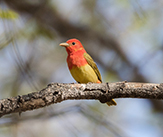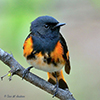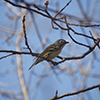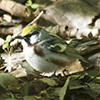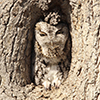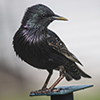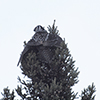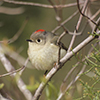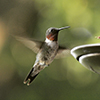Minnesota Birds
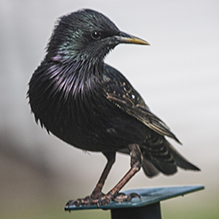
Class Aves
Aves (birds) is the class of animals that is characterized by being warm-blooded, laying hard-shelled eggs, and having a backbone, feathers, wings, a beak with no teeth, and two legs for forelimbs. They are the only clade of dinosaurs (Dinosauria) to have survived the Cretaceous-Paleogene extinction event 65.5 million years ago.
According to the Cornell Lab of Ornithology, there are 11,017 bird species in 250 families worldwide
The American Ornithological Society (AOS) Checklist of North and Middle American Birds covers an area that includes “North and Central America from the North Pole to the boundary of Panama and Colombia, including the adjacent islands under the jurisdiction of the included nations; the Hawaiian Islands; Clipperton Island; Bermuda; The West Indies, including the Bahama Islands, the Greater Antilles, Leeward and Windward Islands in the Lesser Antilles (ending with Grenada); and Swan, Providencia, and San Andrés Islands in the Gulf of Mexico.” The checklist has 2,186 bird species.
According to Avibase – The World Bird Database, hosted by Birds Canada, there are 2,377 bird species in North America north of Mexico, 1,203 species in the United States, and 458 species in Minnesota.
The Minnesota Ornithologists’ Union Checklist of the Birds of Minnesota lists 444 species.
Avian Classification Standard
The classification of birds (avian taxonomy) is a highly dynamic field, constantly being refined by modern scientific advancements, particularly genomic and phylogenetic studies. This ongoing research means that no single taxonomic system is universally accepted across all digital and academic platforms.
For the most accurate and current representation of bird species in this region, MinnesotaSeasons.com follows the standards set by the AOS Check-list of North and Middle American Birds. This list is maintained by the American Ornithological Society (AOS) and is the official taxonomic authority for North America.
We recognize that the AOS classification may differ from other sources you encounter, such as iNaturalist, Wikipedia, or eBird/Clements Check-list. We choose the AOS Check-list because it represents the most recent peer-reviewed consensus and is the standard used by regional ornithological unions (like the Minnesota Ornithological Union).
This means that high-level classifications, such as Tribes and subfamilies, may vary from other sources or even be absent, but they are consistent with the official North American standard.
Recent Additions

White-winged Crossbill (Loxia leucoptera) is a colorful, medium-sized finch. It occurs in the temperate and subpolar regions of the Northern Hemisphere. In Minnesota it is common to uncommon in the northeastern coniferous and mixed forests, occasional to rare in the remainder of the state. Migration is irruptive, with large numbers visiting the state one year and none the following year.
White-winged Crossbill is found mostly in coniferous forests with spruce, tamarack, and eastern hemlock, sometimes in deciduous forests, and sometimes in towns.
Adults feed mostly on spruce and tamarack seeds, but also on the seeds of other coniferous trees and deciduous trees, and occasionally on insects.
White-winged Crossbill breeding male is pinkish-red with black wings and tail. There are two bold white wing bars on each wing. This is the feature that gives the species its common name. The tips of the bill are crossed over, an adaptation that helps when extracting seeds from a spruce seed cone. Females are greenish-yellow streaked with brown.
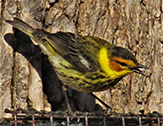
Cape May Warbler (Setophaga tigrina) is a small perching bird but a medium-sized New World Warbler. Its breeds in Canada from Nova Scotia to the Northwest Territories, and in the United States in northern New England and the Upper Midwest. It builds its nest in a mature forest near the top of a tall spruce or balsam fir tree usually near the trunk. In Minnesota it breeds in Arrowhead region. It winters in the West Indies. It is an uncommon migrant in most of the state in May and from early August through October. It is rare in the west. It feeds on insects, especially spruce budworm, and on flower nectar and fruit juices.
Cape May Warbler adult is about 5″ in length and has a wingspan of about 8″. On the breeding male, the upper parts are dark olive green, the chin, sides of the neck (“collar”), and rump are yellow. There is a large chestnut-brown ear patch and a dark eye line. The bill is thin, dark, and slightly curved downward. The breast and flanks are yellow with dark stripes that converge on the throat. The undertail coverts are white. On each wing there is a distinct white patch. The tail is short. The female is paler overall and has two thin white wing patches. The crown is olive-gray and there is a grayish cheek patch.
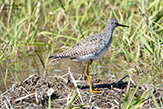
Lesser Yellowlegs (Tringa flavipes) is a medium-sized sandpiper. It nests in meadows and open woodlands from Alaska to Quebec, and winters mostly in South America. It is a common to locally abundant migrant throughout Minnesota from late March to early June and from July to October. In Minnesota it is found in marshes, wet meadows, mudflats, and flooded agricultural fields, and on the shores of lakes and ponds. It eats mostly flies, beetles, and other insects, but also spiders, small fish, snails, crustaceans, worms, and seeds.
The population of Lesser Yellowlegs is declining due to habitat loss in part the result of climate change. However, the species range is extremely large and the species is not considered vulnerable.
A Lesser Yellowlegs looks similar to a Greater Yellowlegs but is smaller. The adult is 10″ to 11″ in length and has a wingspan of 24″. It is a slender shorebird with a small head, a thin bill, and long, bright yellow legs. The nonbreeding plumage is uniformly gray on the upper side with fine, dark streaking. The underparts are white with small gray spots. There is a dark line from the bill to the eye. The bill is straight, thin, entirely black, and about the same length as the head.
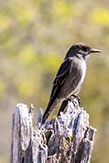
Olive-sided Flycatcher (Contopus cooperi) is a medium-sized tyrant flycatcher (family Tyrannidae) but a large “flycatcher” as that common name is applied. Only Great-crested Flycatcher is larger. It has the longest migration of any North American flycatcher. Breeding grounds are the Rocky and Cascade Mountains from Texas to Alaska, across Canada and the northern border states to Newfoundland and Vermont. In Minnesota the breeding range includes the northeast third of the state. Wintering grounds are mostly in Panama and the northern Andes Mountains from northern Venezuela to western Bolivia.
Olive-sided Flycatcher is the only North American flycatcher to feed exclusively on insects caught in flight. When feeding it perches at the top of a tree or on a dead branch, launching occasionally to catch a flying insect in the air, and returning often to the same perch. Small insects are consumed in the air. Larger insects returned to and beaten against the perch to subdue.
Flycatchers are notoriously difficult to identify by plumage alone. Olive-sided Flycatcher is one exception to this rule. It is easily identified by its white breast and contrasting dark “vest”. It is further distinguished by its large size; indistinct pale wing bars; whitish undertail coverts with well-defined, dark, V-shaped markings; and inconspicuous eye ring.

Ruby-throated Hummingbird (Archilochus colubris) is the smallest breeding bird in the eastern United States and southeastern Canada. It is seldom seen but easily recognized because it is the only hummingbird that breeds in or migrates through Minnesota. It is a migratory bird, arriving in Minnesota in late April and early May. It is a solitary breeder—after mating the male has nothing more to do with the female or its offspring. In the fall, adults migrate across the Gulf of Mexico or along the western coast of Mexico to Central or South America.
Other Recent Additions
This list includes only birds that have been recorded in Minnesota, but not all of the birds found in Minnesota.
| A | ||||||
|---|---|---|---|---|---|---|
| Profile | Photo | Video | Audio | |||
American Golden Plover (Pluvialis dominica) |
||||||
American Pipit (Anthus rubescens) |
||||||
American three-toed woodpecker (Picoides dorsalis) |
||||||
|
||||||
|
||||||
|
||||||
|
||||||
|
||||||
|
||||||
|
||||||
|
||||||
|
||||||
|
||||||
|
||||||
|
||||||
|
||||||
|
||||||
|
||||||
|
||||||
|
||||||
|
||||||
|
|
| B | ||||||
|---|---|---|---|---|---|---|
| Profile | Photo | Video | Audio | |||
Baird’s Sandpiper (Calidris bairdii) |
||||||
Baird’s Sparrow (Ammodramus bairdii) |
||||||
Barn Owl (Tyto alba) |
||||||
Barrow’s Goldeneye (Bucephala islandica) |
||||||
Bay-breasted Warbler (Setophaga castanea) |
||||||
Bell’s Vireo (Vireo bellii) |
||||||
Black-backed Woodpecker (Picoides arcticus) |
||||||
Black-bellied Plover (Pluvialis squatarola) |
||||||
Black-throated Blue Warbler (Setophaga caerulescens) |
||||||
Bonaparte’s Gull (Chroicocephalus philadelphia) |
||||||
Boreal Chickadee (Poecile hudsonicus) |
||||||
Buff-breasted Sandpiper (Tryngites subruficollis) |
||||||
Burrowing Owl (Athene cunicularia) |
||||||
|
||||||
|
||||||
|
||||||
|
||||||
|
||||||
|
||||||
|
||||||
|
||||||
|
||||||
|
||||||
|
||||||
|
||||||
|
||||||
|
||||||
|
||||||
|
||||||
|
||||||
|
||||||
|
||||||
|
||||||
|
||||||
|
||||||
|
||||||
|
||||||
|
||||||
|
||||||
|
||||||
|
||||||
|
||||||
|
||||||
|
||||||
|
||||||
|
||||||
|
||||||
|
||||||
|
||||||
|
||||||
|
||||||
|
||||||
|
||||||
|
||||||
|
||||||
|
||||||
|
||||||
|
| C | ||||||
|---|---|---|---|---|---|---|
| Profile | Photo | Video | Audio | |||
Cackling Goose (Branta hutchinsii) |
||||||
Chestnut-collared Longspur (Calcarius ornatus) |
||||||
Cinnamon Teal (Anas cyanoptera) |
||||||
Clark’s Grebe (Aechmophorus clarkii) |
||||||
Clark’s Nutcracker (Nucifraga columbiana) |
||||||
Common Gallinule (Gallinula galeata) |
||||||
Common Moorhen (Gallinula chloropus) |
||||||
Connecticut Warbler (Oporonis agilis) |
||||||
|
||||||
|
||||||
|
||||||
|
||||||
|
||||||
|
||||||
|
||||||
|
||||||
|
||||||
|
||||||
|
||||||
|
||||||
|
||||||
|
||||||
|
||||||
|
||||||
|
||||||
|
||||||
|
||||||
|
||||||
|
| D | ||||||
|---|---|---|---|---|---|---|
| Profile | Photo | Video | Audio | |||
| Silent | ||||||
Dunlin (Calidris alpina) |
||||||
|
||||||
|
||||||
|
||||||
|
||||||
|
||||||
|
||||||
|
| E | ||||||
|---|---|---|---|---|---|---|
| Profile | Photo | Video | Audio | |||
Eastern Whip-poor-will (Caprimulgus vociferus) |
||||||
|
||||||
|
||||||
|
||||||
|
||||||
|
||||||
|
||||||
|
||||||
|
||||||
|
||||||
|
||||||
|
||||||
|
||||||
|
||||||
|
||||||
|
||||||
|
||||||
|
||||||
|
| F | ||||||
|---|---|---|---|---|---|---|
| Profile | Photo | Video | Audio | |||
Ferruginous Hawk (Buteo regalis) |
||||||
|
||||||
|
||||||
|
||||||
|
||||||
|
| G | ||||||
|---|---|---|---|---|---|---|
| Profile | Photo | Video | Audio | |||
Glaucous Gull (Larus hyperboreus) |
||||||
Greater White-fronted Goose (Anser albifrons) |
||||||
Gyrfalcon (Falco rusticolus) |
||||||
|
||||||
|
||||||
|
||||||
|
||||||
|
||||||
|
||||||
|
||||||
|
||||||
|
||||||
|
||||||
|
||||||
|
||||||
|
||||||
|
||||||
|
||||||
|
||||||
|
||||||
|
||||||
|
||||||
|
||||||
|
||||||
|
||||||
|
||||||
|
||||||
|
| H | ||||||
|---|---|---|---|---|---|---|
| Profile | Photo | Video | Audio | |||
Helmeted Guineafowl (Numida meleagris) |
||||||
Hoary Redpoll (Acanthis hornemanni) |
||||||
Hooded Warbler (Setophaga citrina) |
||||||
Hudsonian Godwit (Limosa haemastica) |
||||||
|
||||||
|
||||||
|
||||||
|
||||||
|
||||||
|
||||||
|
||||||
|
||||||
|
||||||
|
||||||
|
||||||
|
||||||
|
| I | ||||||
|---|---|---|---|---|---|---|
| Profile | Photo | Video | Audio | |||
Iceland Gull (Larus glaucoides) |
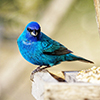 |
|||||
|
||||||
|
| J | ||||||
|---|---|---|---|---|---|---|
| Profile | Photo | Video | Audio | |||
|
||||||
|
| K | ||||||
|---|---|---|---|---|---|---|
| Profile | Photo | Video | Audio | |||
Kentucky Warbler (Geothlypis formosa) |
||||||
| L | ||||||
|---|---|---|---|---|---|---|
| Profile | Photo | Video | Audio | |||
Le Conte’s Sparrow (Ammodramus leconteii) |
||||||
Least Bittern (Ixobrychus exilis) |
||||||
Lesser Black-backed Gull (Larus fuscus) |
||||||
Lincoln’s Sparrow (Melospiza lincolnii) |
||||||
Little Blue Heron (Egrettacaerulea) |
||||||
Long-tailed Duck (Clangula hyemalis) |
||||||
|
||||||
|
||||||
|
||||||
|
||||||
|
||||||
|
||||||
|
||||||
|
||||||
|
||||||
|
| M | ||||||
|---|---|---|---|---|---|---|
| Profile | Photo | Video | Audio | |||
Marsh Wren (Othorus palustris) |
||||||
Mountain Bluebird (Sialia currucoides) |
||||||
Mourning Warbler (Geothlypis tolmiei) |
||||||
Mute Swan (Cygnus olor) |
||||||
|
||||||
|
||||||
|
||||||
|
||||||
|
| N | ||||||
|---|---|---|---|---|---|---|
| Profile | Photo | Video | Audio | |||
Northern Bobwhite (Colinus virginianus) |
||||||
Northern Mockingbird (Mimus polyglottos) |
||||||
Northern Parula (Setophaga americana) |
||||||
Northern Saw-whet Owl (Aegolius acadicus) |
||||||
|
||||||
|
||||||
|
||||||
|
||||||
|
||||||
|
||||||
|
||||||
|
||||||
|
||||||
|
| O | ||||||
|---|---|---|---|---|---|---|
| Profile | Photo | Video | Audio | |||
Orange-crowned Warbler (Vermivora celata) |
||||||
|
||||||
|
||||||
|
||||||
|
||||||
|
| P | ||||||
|---|---|---|---|---|---|---|
| Profile | Photo | Video | Audio | |||
Philadelphia Vireo (Vireo philadelphicus) |
||||||
Pine Siskin (Carduelis pinus) |
||||||
Pine Warbler (Setophaga pinus) |
||||||
Piping Plover (Charadrius melodus) |
||||||
Prairie Falcon (Falco mexicanus) |
||||||
Prairie Warbler (Setophaga discolor) |
||||||
Prothonotary Warbler (Protonotaria citrea) |
||||||
|
||||||
|
||||||
|
||||||
|
||||||
|
||||||
|
| Q | ||||||
|---|---|---|---|---|---|---|
| Profile | Photo | Video | Audio | |||
|
||||||
|
| R | ||||||
|---|---|---|---|---|---|---|
| Profile | Photo | Video | Audio | |||
Red Knot (Calidris canutus) |
||||||
Red-necked Phalarope (Phalaropus lobatus) |
||||||
Red-throated Loon (Gavia stellata) |
||||||
Ross’s Goose (Chen rossii) |
||||||
|
||||||
|
||||||
|
||||||
|
||||||
|
||||||
|
||||||
|
||||||
|
||||||
|
||||||
|
||||||
|
||||||
|
||||||
|
||||||
|
||||||
|
||||||
|
||||||
|
||||||
|
||||||
|
||||||
|
||||||
|
||||||
|
||||||
|
||||||
|
||||||
|
||||||
|
||||||
|
||||||
|
||||||
|
||||||
|
||||||
|
||||||
|
||||||
|
||||||
|
||||||
|
| S | ||||||
|---|---|---|---|---|---|---|
| Profile | Photo | Video | Audio | |||
Sanderling (Calidris alba) |
||||||
Say’s Phoebe (Sayornis saya) |
||||||
Semipalmated Plover (Charadrius semipalmatus) |
||||||
Semipalmated Sandpiper (Calidris pusilla) |
||||||
Sprague’s Pipit (Anthus spragueii) |
||||||
Spruce Grouse (Falcipennis canadensis) |
||||||
Stilt Sandpiper (Calidris himantopus) |
||||||
Surf Scoter (Melanitta perspicillata) |
||||||
Swainson’s Hawk (Buteo swainsoni) |
||||||
|
||||||
|
||||||
|
||||||
|
||||||
|
||||||
|
||||||
|
||||||
|
||||||
|
||||||
|
||||||
|
||||||
|
||||||
|
||||||
|
||||||
|
||||||
|
||||||
|
| T | ||||||
|---|---|---|---|---|---|---|
| Profile | Photo | Video | Audio | |||
Townsend’s Solitaire (Myadestes townsendi) |
||||||
Tricolored Heron (Egretta tricolor) |
||||||
true swans (Cygnus spp.) |
||||||
|
||||||
|
||||||
|
||||||
|
||||||
|
| U | ||||||
|---|---|---|---|---|---|---|
| Profile | Photo | Video | Audio | |||
|
| V | ||||||
|---|---|---|---|---|---|---|
| Profile | Photo | Video | Audio | |||
Varied Thrush (Ixoreus naevius) |
||||||
|
||||||
|
| W | ||||||
|---|---|---|---|---|---|---|
| Profile | Photo | Video | Audio | |||
Warbling Vireo (Vireo gilvus) |
||||||
Western Kingbird (Tyrannus verticalis) |
||||||
White-rumped Sandpiper (Calidris fuscicollis) |
||||||
White-winged Scoter (Melanitta deglandi) |
||||||
Whooping Crane (Grus americana) |
||||||
Willow Flycatcher (Empidonax traillii) |
||||||
Winter Wren (Troglodytes troglodytes) |
||||||
|
||||||
|
||||||
|
||||||
|
||||||
|
||||||
|
||||||
|
||||||
|
||||||
|
||||||
|
||||||
|
||||||
|
||||||
|
| X | ||||||
|---|---|---|---|---|---|---|
| Profile | Photo | Video | Audio | |||
|
||||||
|
| Y | ||||||
|---|---|---|---|---|---|---|
| Profile | Photo | Video | Audio | |||
Yellow-billed Cuckoo (Coccyzus americanus) |
||||||
Yellow-crowned Night-heron (Nyctanassa violacea) |
||||||
Yellow-throated Vireo (Vireo flavifrons) |
||||||
|
||||||
|
||||||
|
||||||
|
||||||
|
||||||
|
||||||
|
| Z | ||||||
|---|---|---|---|---|---|---|
| Profile | Photo | Video | Audio | |||
|
||||||
|
Acanthis flammea (Common Redpoll)
Acanthis hornemanni (Hoary Redpoll)
Accipiter cooperii (Cooper’s Hawk)
Accipiter atricapillus (American Goshawk)
Accipiter striatus (Sharp-shinned Hawk)
Actitis macularius (Spotted Sandpiper)
Aechmophorus clarkii (Clark’s Grebe)
Aechmophorus occidentalis (Western Grebe)
Aegolius acadicus (Northern Saw-whet Owl)
Aegolius funereus (Boreal Owl)
Agelaius phoeniceus (Red-winged Blackbird)
Ammodramus bairdii (Baird’s Sparrow)
Ammodramus leconteii (Le Conte’s Sparrow)
Ammodramus savannarum (Grasshopper Sparrow)
Ammospiza nelsoni (Nelson’s Sparrow)
Spatula clypeata (Northern Shoveler)
Anas crecca (Green-winged Teal)
Anas cyanoptera (Cinnamon Teal)
Anas rubripes (American Black Duck)
Anser albifrons (Greater White-fronted Goose)
Anser caerulescens (Snow Goose)
Anser rossii (Ross’s Goose)
Anthus rubescens (American Pipit)
Anthus spragueii (Sprague’s Pipit)
Antigone canadensis (Sandhill Crane)
Aquila chrysaetos (Golden Eagle)
Archilochus colubris (Ruby-throated Hummingbird)
Ardea herodias (Great Blue Heron)
Arenaria interpres (Ruddy Turnstone)
Asio flammeus (Short-eared Owl)
Athene cunicularia (Burrowing Owl)
Baeolophus bicolor (Tufted Titmouse)
Bartramia longicauda (Upland Sandpiper)
Bombycilla cedrorum (Cedar Waxwing)
Bombycilla garrulus (Bohemian Waxwing)
Bonasa umbellus (Ruffed Grouse)
Botaurus lentiginosus (American Bittern)
Branta canadensis (Canada Goose)
Branta hutchinsii (Cackling Goose)
Bubo virginianus (Great Horned Owl)
Bubulcus ibis (Western Cattle Egret)
Bucephala albeola (Bufflehead)
Bucephala clangula (Common Goldeneye)
Bucephala islandica (Barrow’s Goldeneye)
Buteo jamaicensis (Red-tailed Hawk)
Buteo lagopus (Rough-legged Hawk)
Buteo lineatus (Red-shouldered Hawk)
Buteo platypterus (Broad-winged Hawk)
Buteo regalis (Ferruginous Hawk)
Buteo swainsoni (Swainson’s Hawk)
Calcarius lapponicus (Lapland Longspur)
Calcarius ornatus (Chestnut-collared Longspur)
Calidris alba (Sanderling)
Calidris alpina (Dunlin)
Calidris bairdii (Baird's Sandpiper)
Calidris canutus (Red Knot)
Calidris fuscicollis (White-rumped Sandpiper)
Calidris himantopus (Stilt Sandpiper)
Calidris melanotos (Pectoral Sandpiper)
Calidris minutilla (Least Sandpiper)
Calidris pusilla (Semipalmated Sandpiper)
Caprimulgus vociferus (Eastern Whip-poor-will)
Cardellina canadensis (Canada Warbler)
Cardellina pusilla (Wilson’s Warbler)
Cardinalis cardinalis (Northern Cardinal)
Carduelis pinus (Pine Siskin)
Cathartes aura (Turkey Vulture)
Catharus guttatus (Hermit Thrush)
Catharus minimus (Gray-cheeked Thrush)
Catharus spp. (brown thrushes and nightingale-thrushes)
Catharus ustulatus (Swainson’s Thrush)
Centronyx henslowii (Henslow’s Sparrow)
Certhia americana (Brown Creeper)
Chaetura pelagica (Chimney Swift)
Charadrius melodus (Piping Plover)
Charadrius semipalmatus (Semipalmated Plover)
Charadrius vociferus (Killdeer)
Chondestes grammacus (Lark Sparrow)
Chordeiles minor (Common Nighthawk)
Chroicocephalus philadelphia (Bonaparte’s Gull)
Circus hudsonius (Northern Harrier)
Cistothorus platensis (Sedge Wren)
Clangula hyemalis (Long-tailed Duck)
Coccothraustes vespertinus (Evening Grosbeak)
Coccyzus americanus (Yellow-billed Cuckoo)
Coccyzus erythropthalmus (Black-billed Cuckoo)
Colaptes auratus (Northern Flicker)
Colinus virginianus (Northern Bobwhite)
Contopus cooperi (Olive-sided Flycatcher)
Contopus virens (Eastern Wood-peewee)
Coragyps atratus (Black Vulture)
Corvus brachyrhynchos (American Crow)
Coturnicops noveboracensis (Yellow Rail)
Cyanocitta cristata (Blue Jay)
Cygnus buccinator (Trumpeter Swan)
Cygnus columbianus (Tundra Swan)
Cygnus olor (Mute Swan)
Cygnus spp. (true swans)
Egretta tricolor (Tricolored Heron)
Egrettacaerulea (Little Blue Heron)
Empidonax alnorum (Alder Flycatcher)
Empidonax flaviventris (Yellow-bellied Flycatcher)
Empidonax minimus (Least Flycatcher)
Empidonax traillii (Willow Flycatcher)
Empidonax virescens (Acadian Flycatcher)
Eremophila alpestris (Horned Lark)
Falcipennis canadensis (Spruce Grouse)
Falco mexicanus (Prairie Falcon)
Falco peregrinus (Peregrine Falcon)
Falco rusticolus (Gyrfalcon)
Gallinago delicata (Wilson’s Snipe)
Gallinula chloropus (Common Moorhen)
Gallinula galeata (Common Gallinule)
Gavia stellata (Red-throated Loon)
Geothlypis formosa (Kentucky Warbler)
Geothlypis tolmiei (Mourning Warbler)
Geothlypis trichas (Common Yellowthroat)
Grus americana (Whooping Crane)
Icterus galbula (Baltimore Oriole)
Icterus spurius (Orchard Oriole)
Ixobrychus exilis (Least Bittern)
Ixoreus naevius (Varied Thrush)
Lanius borealis (Northern Shrike)
Lanius ludovicianus (Loggerhead Shrike)
Larus argentatus (Herring Gull)
Larus delawarensis (Ring-billed Gull)
Larus fuscus (Lesser Black-backed Gull)
Larus glaucoides (Iceland Gull)
Larus hyperboreus (Glaucous Gull)
Leiothlypis peregrina (Tennessee Warbler)
Leiothlypis ruficapilla (Nashville Warbler)
Leuconotopicus villosus (Hairy Woodpecker)
Leucophaeus atricilla (Laughing Gull)
Leucophaeus pipixcan (Franklin’s Gull)
Limnodromus griseus (Short-billed Dowitcher)
Limnodromus scolopaceus (Long-billed Dowitcher)
Limosa haemastica (Hudsonian Godwit)
Lophodytes cucullatus (Hooded Merganser)
Mareca americana (American Widgeon)
Megaceryle alcyon (Belted Kingfisher)
Megascops asio (Eastern Screech-owl)
Melanerpes carolinus (Red-bellied Woodpecker)
Melanerpes erythrocephalus (Red-headed Woodpecker)
Melanerpes lewis (Lewis’s Woodpecker)
Melanitta deglandi (White-winged Scoter)
Melanitta nigra (Black Scoter)
Melanitta perspicillata (Surf Scoter)
Meleagris gallopavo (Wild Turkey)
Melospiza georgiana (Swamp Sparrow)
Melospiza lincolnii (Lincoln’s Sparrow)
Melospiza melodia (Song Sparrow)
Mergus merganser (Common Merganser)
Mergus serrator (Red-breasted Merganser)
Mimus polyglottos (Northern Mockingbird)
Mniotilta varia (Black-and-white Warbler)
Molothrus ater (Brown-headed Cowbird)
Myadestes townsendi (Townsend’s Solitaire)
Nucifraga columbiana (Clark’s Nutcracker)
Numenius americanus (Long-billed Curlew)
Numida meleagris (Helmeted Guineafowl)
Nyctanassa violacea (Yellow-crowned Night-heron)
Oporonis agilis (Connecticut Warbler)
Othorus palustris (Marsh Wren)
Parkesia motacilla (Louisiana Waterthrush)
Parkesia noveboracensis (Northern Waterthrush)
Passer domesticus (House Sparrow)
Passerculus sandwichensis (Savannah Sparrow)
Passerella iliaca (Fox Sparrow)
Passerina amoena (Lazuli Bunting)
Passerina caerulea (Blue Grosbeak)
Passerina cyanea (Indigo Bunting)
Pelecanus erythrorhynchos (American White Pelican)
Pelecanus occidentalis (Brown Pelican)
Perdix perdix (Gray Partridge)
Perisoreus canadensis (Canada Jay)
Petrochelidon pyrrhonota (Cliff Swallow)
Phalacrocorax auritus (Double-crested Cormorant)
Phalaropus lobatus (Red-necked Phalarope)
Phalaropus tricolor (Wilson’s Phalarope)
Phasianus colchicus (Ring-necked Pheasant)
Pheucticus ludovicianus (Rose-breasted Grosbeak)
Pica hudsonia (Black-billed Magpie)
Picoides arcticus (Black-backed Woodpecker)
Picoides dorsalis (American three-toed woodpecker)
Pinicola enucleator (Pine Grosbeak)
Pipilo erythrophthalmus (Eastern Towhee)
Pipilo maculatus (Spotted Towhee)
Piranga olivacea (Scarlet Tanager)
Piranga rubra (Summer Tanager)
Plectrophenax nivalis (Snow Bunting)
Plegadis chihi (White-faced Ibis)
Plegadis falcinellus (Glossy Ibis)
Pluvialis dominica (American Golden Plover)
Pluvialis squatarola (Black-bellied Plover)
Podiceps auritus (Horned Grebe)
Podiceps grisegena (Red-necked Grebe)
Podiceps nigricollis (Eared Grebe)
Podilymbus podiceps (Pied-billed Grebe)
Poecile atricapillus (Black-capped Chickadee)
Poecile hudsonicus (Boreal Chickadee)
Polioptila caerulea (Blue-gray Gnatcatcher)
Pooecetes gramineus (Vesper Sparrow)
Protonotaria citrea (Prothonotary Warbler)
Sayornis phoebe (Eastern Phoebe)
Sayornis saya (Say’s Phoebe)
Scolopax minor (American Woodcock)
Seiurus aurocapilla (Ovenbird)
Setophaga americana (Northern Parula)
Setophaga caerulescens (Black-throated Blue Warbler)
Setophaga castanea (Bay-breasted Warbler)
Setophaga cerulea (Cerulean Warbler)
Setophaga citrina (Hooded Warbler)
Setophaga coronata (Yellow-rumped Warbler)
Setophaga discolor (Prairie Warbler)
Setophaga fusca (Blackburnian Warbler)
Setophaga magnolia (Magnolia Warbler)
Setophaga palmarum (Palm Warbler)
Setophaga pensylvanica (Chestnut-sided Warbler)
Setophaga petechia (Yellow Warbler)
Setophaga pinus (Pine Warbler)
Setophaga ruticilla (American Redstart)
Setophaga striata (Blackpoll Warbler)
Setophaga tigrina (Cape May Warbler)
Setophaga virens (Black-throated Green Warbler)
Sialia currucoides (Mountain Bluebird)
Sialia sialis (Eastern Bluebird)
Sitta canadensis (Red-breasted Nuthatch)
Sitta carolinensis (White-breasted Nuthatch)
Spatula discors (Blue-winged Teal)
Sphyrapicus varius (Yellow-bellied Sapsucker)
Spinus tristis (American Goldfinch)
Spizella pallida (Clay-colored Sparrow)
Spizella passerina (Chipping Sparrow)
Spizella pusilla (Field Sparrow)
Spizelloides arborea (American Tree Sparrow)
Stelgidopteryx serripennis (Northern Rough-winged Swallow)
Sterna forsteri (Forster’s Tern)
Streptopelia decaocto (Eurasian Collared-Dove)
Strix nebulosa (Great Gray Owl)
Strix varia (Barred Owl)
Sturnella magna (Eastern Meadowlark)
Sturnella neglecta (Western Meadowlark)
Tachycineta bicolor (Tree Swallow)
Toxostoma rufum (Brown Thrasher)
Tringa flavipes (Lesser Yellowlegs)
Tringa melanoleuca (Greater Yellowlegs)
Tringa solitaria (Solitary Sandpiper)
Troglodytes aedon (House Wren)
Troglodytes troglodytes (Winter Wren)
Tryngites subruficollis (Buff-breasted Sandpiper)
Turdus migratorius (American Robin)
Tympanuchus cupido (Greater Prairie-chicken)
Tympanuchus phasianellus (Sharp-tailed Grouse)
Tyrannus tyrannus (Eastern Kingbird)
Tyrannus verticalis (Western Kingbird)
Vermivora celata (Orange-crowned Warbler)
Vermivora chrysoptera (Golden-winged Warbler)
Vermivora cyanoptera (Blue-winged Warbler)
Vireo bellii (Bell’s Vireo)
Vireo flavifrons (Yellow-throated Vireo)
Vireo gilvus (Warbling Vireo)
Vireo olivaceus (Red-eyed Vireo)
Vireo philadelphicus (Philadelphia Vireo)
No Species Page Yet?
If you do not see a linked page for a species in the list at left you can still upload a photo or video or report a sighting for that species. Click on one of the buttons below and type in the common name and/or scientific name of the species in your photo, video, or sighting. A new page will be created for that species featuring your contribution.
These buttons not working for you?
Simply email us at info@MinnesotaSeasons.com.
Capitalization of Common Names
Bird common names are governed by the International Ornithologists’ Union (IOU). In 1991 the IOU began a project to standardize English language names of birds. The goal was to officially sanction a single, unique name for each species. In 2006 the project was completed and the resulting list was published in book form as Birds of the World: Recommended English Names, by Frank Gill & Minturn Wright. According to the IOU, English language bird names have “graduated from the realm of ‘common/vernacular’ names,” and must be regarded as proper nouns. For this reason, bird common names are capitalized.




